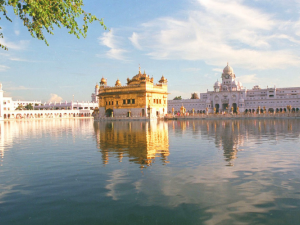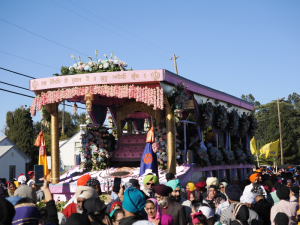Akal Takat Edict Directs Gurdwaras to Revert to Nishan Sahib Traditional Colors
Elevated high above the gurdwara, the noble Nishan Sahib (exalted ensign) shimmering in the sunlight is an awe-inspiring sight. Most Sikhs will remember their noble banner as being a deep orange (kesri) flag embellished with a royal blue (neela) Khanda insignia. However, in July of 2024, the Akal Takat (Supreme Secular Seat of Sikhi) convened and on August 9, 2024, released an edict mandating that all gurdwaras revert to comply with Sikh Rehit Maryada (SRM) mandated colors of tradition:
Sikh Rehit Maryada Code of Conduct and Conventions (SRM) Page Section Three Chapter IV Article V (r)
“At a high-level site in every gurdwara should be installed the Nishan Sahib (Sikh flag). The cloth of the flag should be either of xanthic or of greyish blue colour and on top of the flag post, there should either be a spearhead or a Khanda (a straight dagger with convex side edges leading to slanting top edges ending in a vertex).”
This proclamation comes as a surprise to many after decades of seeing the orange and blue Nishan Sahib as the most common banner flown. There have been a few protests, but most gurdwaras are gracefully working towards compliance with traditional yellow (xanthic/basanti) and indigo (greyish-blue/surmaiee) for Nishan Sahib colors.
Evolution of Nishan Sahib
Over the centuries, the Nishan Sahib colors have evolved. From the beginning, the Sikhs have always had a triangular banner or pennant. First Guru Nanak raised a white (chittaa, or dhaula/dhaval) pennant thought by some scholars to have been inscribed with the emblem Ik Oankaar. Third Guru Amar Das erected a white banner in Goindwal at the well of Baoli Sahib on the bank of River Beas. Guru Hargobind donned two swords and hoisted a yellow (basanti) banner to fly above his Takhat (throne) declaring Sikh sovereignty. Guru Gobind Singh flew a deep blue indigo (surmaiee) banner. Sikhs at that time referred to their flag as “Akal Dhuja” (timeless banner), or “Satguru Nishan” (True Guru's insignia).
The triangular banner evolved, over time, to be embellished with silhouettes of a contrasting color having three weapons (shastar), a shield (dhal), a short straight sword mounted to be clutched with the fist and strapped to the wrist (kattaar), and a sword (kirpan). Prior to British occupation, the traditional triangular banner flew straight across the top from its pole with the angle of its slope slanting from bottom to top, exactly opposite of the modern-day Nishan Sahib, which has a downward slant. It is presumed by many that, the downward tip of the triangle represented British subjugation, and that the orange (kesri) coloring of Nishan Sahib may have begun as a protest to the British Raj.
During the 1930s, the Khanda emblem became the standard insignia of the Sikhs. In 1936, after 14 years of consultations with all prominent Sikh leaders of every group, the Sikh Rehit Maryrada (SRM), became the official code and conduct and convention for all Sikhs and mandated Nishan Sahib colors to be basanti and surmaiee. Gurdwaras flew the yellow (basanti) Nishan Sahib up until 1984. Following the government invasion of Harmandir Sahib, the Golden Temple complex, Sikhs began displaying the orange (kesri) Nishan Sahib and wearing dastar (turban) of the same color as a form of protest against oppression.
As of August 9, 2024, the appearance of Nishan Sahib has again been mandated to be either a Basanti (yellow) banner embellished with Surmaiee (indigo) Khanda and Tassel, or a Surmaiee (indigo) banner embellished with a Basanti (yellow) Khanda and Tassel.
Significance and Symbology of Nishan Sahib
Shape: Triangular with a tassel of contrasting color at its tip. The original angle of the triangular Nishan Sahib, with its straight edge along the top to its tip, is said to have changed during the occupation of the British Raj.
Fabric: Nishan Sahib fabric (kapparr) is generally of cotton. Satin or silk cloth may also be used for its shimmering effect, as the banner can be seen, glistening in the sun, from afar.
Colors: The Basanti (yellow-colored) banner is generally erected at gurdwaras, while the warrior sects Akali Dal, or Nihangs, fly the Surmaiee (indigo-colored) banner. Two Nishan Sahibs, one of each color have been traditionally erected between the Akal Takhat and Harmandir Sahib Darbar in Amritsar.
Nishan Sahib colors can be related to symbolic meanings:
- Dhaval Dhuja – The former white Sikh flag symbolized Piri, a state of purity, saintliness, goodwill, and peace.
- Basanti – Xantic is a light, bright yellow color like mustard flowers, or the darker rich yellow of the condiment mustard, and represents sacrifice.
- Surmaiee – The name of this color is taken from Surmaa, or Antimony Sulphide, a black crystalline mineral, that can be in the range of black, grey, navy blue, or the deepest dark blue of indigo, traditionally worn, and used for banners, by Khalsa warriors.
- Kesri – Saffron, or orange color, representative of abandoning, forsaking, or relinquishing, has been part of the protest against oppression. The Kesri Lahar movement for freedom from oppression involved a wave of orange pennants flown from vehicles, and orange dastars (turbans) worn by protesters.
- Neela – Royal blue represents a commitment to traditional Sikhi and its values.
Ornamentation: The Nishan Sahib flag pole is traditionally covered with the same cloth as the banner and has a teer (spearhead) or khanda (double-edged broadsword) affixed to the top of it. Often there will be lighting strung on the pole so that the Nishan Sahib can be seen after dark.
Insignia Emblems: The Modern-day Khanda, composed of three types of Shastar (weaponry) symbolizes three main aspects, and the slogan of Sikhi, “Deg, Teg, Fateh” which translates to mean,” Victorious is the kitchen and sword”:
- Deg – symbolizes charity, the sharing of honestly earned income can mean a large iron cooking vessel used in the Guru’s langar (free kitchen), or the kitchen itself where free food is served to all takers as well as prashad, (a sacred sweet distributed to worshipers).
- Teg – refers to the sword used only for defense of the oppressed.
- Fateh – Victorious Victory against oppression achieved through selfless service, charity, honesty, and the righteous use of the sword when all other means fail.
The three weapons represented by the Khanda insignia include:
- Chakkar – A circular ring, worn by a Khalsa warrior and used as a throwing weapon, symbolizes the soul's unity with infinity, a sense of being at one with everything.
- Khanda – A double-edged flat broadsword used to stir sugar into water representing immortal nectar drunk by initiates in the initiation ceremony of Amritsanchar. Its two sharpened edges symbolize the ability of truth to cut through the duality of illusory separation of the soul from the divine.
- Kirpans – Two kirpans on either side of the khanda symbolize Piri and Miri signify both the spiritual and secular aspects of Sikh sovereignty.
The Nishan Sahib flies year-round whatever the weather. Usually, it is replaced on Vaisakhi Day in mid-April. The banner is ceremoniously taken down and then the pole is lowered and bathed with milk by devoted sangat members to clean it and prevent it from rusting. A fresh new Nishan Sahib is then raised to fly high above the gurdwara.
The Significance Nishan Sahib in Gurbani
Every era of Gurbani, from Guru Nanak through Guru Gobind Singh and beyond, praises the importance, merits, and metaphoric qualities of the Nishan Sahib, Sikh banners and pennants:
ਅਮੁਲੁ ਬਖਸੀਸ ਅਮੁਲੁ ਨੀਸਾਣੁ ॥
amul bakhasees amul neesaann ||
Priceless are His Blessings, Priceless is His Banner and Insignia.
Guru Nanak SGGS || Ang 5
ਸਚੈ ਸਬਦਿ ਨੀਸਾਣਿ ਠਾਕ ਨ ਪਾਈਐ ॥
sachai sabad neesaann tthaak na paeeaai ||
No one obstructs the way of those blessed with the Banner of the True Word.
Guru Angad SGGS || Ang 146
ਕਰਮਿ ਪਵੈ ਨੀਸਾਨੁ ਨ ਚਲੈ ਚਲਾਇਆ ॥
karam pavai neesaan na chalai chalaiaa ||
By Your Grace, is the banner of honor obtained, it cannot be taken or lost.
Guru Angad SGGS || Ang 150
ਦੁਲਭ ਦੇਹ ਹੋਈ ਪਰਵਾਨੁ ॥
hulabh deh hoee parvaan ||
This human body, so difficult to obtain, is redeemed
ਸਤਿਗੁਰ ਤੇ ਪਾਇਆ ਨਾਮ ਨੀਸਾਨੁ ॥੨॥
satigur tae paiaa naam neesaan ||2||
when, from the True Guru, one receives the banner of the Name. ||2||
Guru Arjan SGGS || Ang 193
ਗੁਰ ਕੈ ਸਬਦਿ ਨਾਮਿ ਨੀਸਾਣੁ ॥੧॥ ਰਹਾਉ ॥
gur kai sabad naam neesaann ||1|| rahaau ||
By the Word of the Guru, is one blessed with the insignia and banner of the Name. ||1||Pause||
Guru Amar Das SGGS || Ang 1175
ਜਿਸੁ ਧੀਰਜੁ ਧੁਰਿ ਧਵਲੁ ਧੁਜਾ ਸੇਤਿ ਬੈਕੁੰਠ ਬੀਣਾ ॥
jis dheeraj dhur dhaval dhujaa saet baikuntth beenaa ||
Patience has been His white banner since the beginning of time, planted on the bridge to heaven.
Bhatt Kal in praise of Guru Amar Daas SGGS || Ang 1393
ਝੂਲਣ ਨੇਜੇ ਬੈਰਕਾ ਨੀਸਾਣ ਲਸਨਿ ਲਸਾਵਲੇ ॥
jhoolan naejae bairkaa neesaann lasan lasaavle ||
The lances swung and the lustrous tassels of the pennants glistened.
Guru Gobind Singh Dasm Granth ||Pannaa 120
ਖੜਗ ਕੇਤ ਮੈ ਸਰਣਿ ਤਿਹਾਰੀ ॥
kharrag kaet mai saran tihaaree ||
O Immortal Being (with the sword on Your banner)! I am under Your protection.
ਆਪ ਹਾਥ ਦੈ ਲੇਹੁ ਉਬਾਰੀ ॥
aap haath dai leh ubaaree ||
Give me Your hand and save me.
Guru Gobind Singh Dasm Granth (Benti Choupai) || Pannaa 1836
ਜਿਨਿ ਸਭ ਪ੍ਰਿਥਵੀ ਕਉ ਜੀਤ ਕਰਿ ਨੀਸਾਨ ਝੁਲਾਏ॥
jin sabh prithavee kau jeet kar neesaan jhulaa-ae||
He triumphed over the whole world and unfurled the sacred flags.
Bhai Gurdas Singh Vaaran || Pannaa 19
Traditional Nishan Sahib Colors and Return to Sikh Rehit Maryada
A return to honoring and upholding the mandates of the Sikh Code of Conduct and Conventions, to fly traditional basanti and surmaiee colors of the noble Nishan Sahib high over the gurdwaras around the world, ultimately strengthens and unifies the Sikh Panth. The kesri color we know and love will undoubtedly continue to have an honored place in the ongoing quest of Sikhi to stand united against tyranny and oppression.





